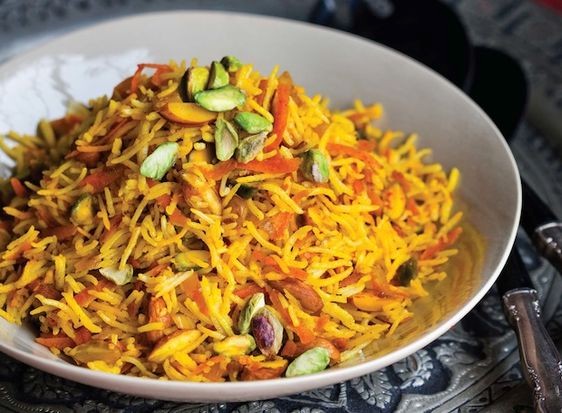Spice support: saffron
December 10, 2018 by DarcieYou probably already know that saffron is the world’s most expensive spice, but have you ever seen a saffron harvest? Through a series of photos, The Guardian guides us through the painstaking process in the saffron fields of the Patsiouras family in Greece, where the crocus that brings us the rare spice is being grown in ever larger numbers.

As you see the harvest taking place, you can easily realize why the spice is so expensive. A single flower produces just 0.0011 ounces of saffron, and each red-gold thread – the stigma of the flower crocus sativus – must be carefully plucked by hand. Saffron has been cultivated in the Middle East for centuries, with the first known image of the spice dating to the Bronze Age.
Over its long history, saffron has been used as a spice, a dye for fabric, an ingredient in perfume, and as medicine. The spice’s flavor has been described as grassy and hay-like, but it defies adequate description. One writer eloquently summarized saffron’s elusive aroma and flavor: “The aroma and flavor of saffron is unique and difficult to describe. It is floral, but not sweet. It is warm and earthy, but not pungent. It is smooth and gentle, yet assertive. It is unmistakable, heady and wonderful.”
Another site describes the flavor as “a blend of earth, tabacco, vanilla, honey, salty sweet.” Saffron is used extensively in Persian cuisine, but it is also found in the foods of many other cultures such as bouillabaisse (French), paella (Spanish), risotto (Italian) and biryani (Indian). The spice imparts a rich golden color to any dish to which it is added.
Iran is far and away the largest producer of saffron, with up nearly 90% of the world’s supply coming from that country. It is also grown in Spain, Italy, Greece, and in a handful of other countries, although the output in most places often only amounts to a few kilograms per harvest. Since the spice is incredibly expensive, fake and adultered versions abound, so it pays to know your spice merchant to ensure you are getting the real thing. Saffron is graded, with the best (and most expensive) grades containing only the red portions of the pistil (called the stigma), with lesser grades containing more of the yellow portion of the pistil.
If you want to make sure your saffron is genuine, place a thread into a small amount of water. True saffron will not lose its original color after it is has been placed in the water, but a fake version will lose its added color. Additionally, if the water turns color immediately after the saffron is added, it’s likely a fraud. It takes several minutes for real saffron to impart color into a liquid.
Photo of Sweet rice with carrots and rice (Shirin polo) from The New Persian Kitchen by Louisa Shafia
Categories
- All Posts (6940)
- Antipasto (2135)
- Author Articles (247)
- Book News (935)
- Cookbook Giveaways (983)
- Cookbook Lovers (257)
- Cooking Tips (109)
- Culinary News (299)
- Food Biz People (552)
- Food Online (791)
- Holidays & Celebrations (272)
- New Cookbooks (149)
- Recipes (1500)
- Shelf Life With Susie (231)
- What's New on EYB (133)
Archives
Latest Comments
- Pamsy on What foods do you look forward to the most for each season?
- Pamsy on How cookbooks can help build resilience
- DarcyVaughn on Danube Cookbook Review and Giveaway
- hettar7 on JoyFull – Cookbook Review & Giveaway
- eliza on What foods do you look forward to the most for each season?
- kmwyman on Rooza by Nadiya Hussain – Cookbook Review and Giveaway
- Maryd8822 on The Golden Wok – Cookbook Giveaway
- Dendav on Danube Cookbook Review and Giveaway
- sanfrannative on Rooza by Nadiya Hussain – Cookbook Review and Giveaway
- darty on Danube Cookbook Review and Giveaway